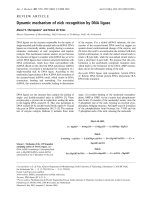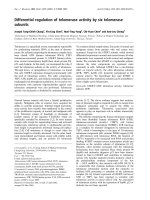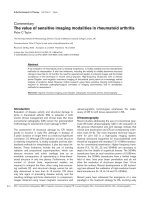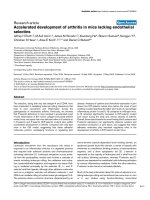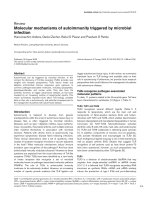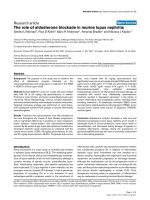Báo cáo y học: "Mating rhythms of Drosophila: rescue of tim01 mutants by D. ananassae timeless'''' pdf
Bạn đang xem bản rút gọn của tài liệu. Xem và tải ngay bản đầy đủ của tài liệu tại đây (674.73 KB, 6 trang )
BioMed Central
Page 1 of 6
(page number not for citation purposes)
Journal of Circadian Rhythms
Open Access
Research
Mating rhythms of Drosophila: rescue of tim
01
mutants by D.
ananassae timeless
Izumi Nishinokubi
1
, Masami Shimoda
2
and Norio Ishida*
1,3
Address:
1
Clock Cell Biology, National Institute of Advanced Industrial Science and Technology, Institute of Molecular and Cell Biology, Tsukuba
305-8566, Japan,
2
National Institute of Agrobiological Sciences, Tsukuba 305-8634, Japan and
3
Institute of Applied Biochemistry, University of
Tsukuba, Tsukuba 305-8576, Japan
Email: Izumi Nishinokubi - ; Masami Shimoda - ; Norio Ishida* -
* Corresponding author
Abstract
Background: It is reported that the circadian rhythms of female mating activity differ among
Drosophila species and are controlled by an endogenous circadian clock. Here, we found that the
mating rhythm of D. ananassae differed from that of D. melanogaster. Moreover, to evaluate the
effect of clock gene products on mating activities, we examined the mating activity of D.
melanogaster timeless (tim
01
) transgenic fly harboring heat-shock promotor driven-D. ananassae
timeless (tim) gene (hs-AT tim
01
).
Methods: Flies were maintained under light/dark (LD) cycles for several days and then they were
transferred to constant dark (DD) conditions at 25°C. Transformant flies were heat-shocked for
30 min (PZT 10.5–11.0 or PZT 22.5–23.0; PZT means Projected Zeitgeber Time) at 37°C every
day. Daily expressions of D. ananassae TIMELESS (TIM) protein in transgenic flies were measured
by western blotting. To examine whether the timing of D. ananassae TIM protein induction by heat
shock can change the patterns of the behavior activities of D. melanogaster tim
01
flies, we measured
locomotor and mating activity rhythms under DD at 25°C ± 0.5°C except when heat shock was
applied.
Results: Heat shock applied at PZT 10.5–11.0 and at PZT 22.5–23.0 induced high TIM levels during
subjective night and day, respectively, in hs-AT tim
01
flies. The locomotor rhythm of these flies was
changed from diurnal to nocturnal by the timing of D. ananassae TIM induction. However, the
mating rhythm of these flies could not be entrained by the timing of D. ananassae TIM induction.
Conclusion: The pattern of mating activity rhythms of D. ananassae and of D. melanogaster
differed. The mating activity rhythms of D. melanogaster tim
01
flies harboring hs-AT tim appeared
after heat-shock but the pattern and phase differed from those of wild-type D. ananassae and D.
melanogaster. Moreover, the mating rhythm of these flies could not be entrained by the timing of
D. ananassae TIM induction although the locomotor rhythm of hs-AT tim
01
was changed from
diurnal to nocturnal according to the timing of D. ananassae TIM induction. These data suggest that
species-specific mating activities require output pathways different from those responsible for
locomotor rhythms.
Published: 08 March 2006
Journal of Circadian Rhythms2006, 4:4 doi:10.1186/1740-3391-4-4
Received: 15 December 2005
Accepted: 08 March 2006
This article is available from: />© 2006Nishinokubi et al; licensee BioMed Central Ltd.
This is an Open Access article distributed under the terms of the Creative Commons Attribution License ( />),
which permits unrestricted use, distribution, and reproduction in any medium, provided the original work is properly cited.
Journal of Circadian Rhythms 2006, 4:4 />Page 2 of 6
(page number not for citation purposes)
TIM protein levels and locomotor activity rhythm in flies receiving heat shock under DD conditionsFigure 1
TIM protein levels and locomotor activity rhythm in flies receiving heat shock under DD conditions. D. ananas-
sae TIM protein was induced by heat shock at PZT 10.5–11.0 (A) and at PZT 22.5–23.0 (B) in w, tim
01
, hs-D. ananassae tim flies.
Heat shock at 37°C for 30 minutes every day rapidly induced TIM. The dotted lines depict data from non-heat-shocked control
flies. (C) and (D) are representative double-plot actgrams of locomotor activitys of transgenic flies that were heat shocked at
PZT 10.5–11.0 (C) and PZT 22.5–23.0 (D), respectively. Dark and shaded bars show subjective night and day under DD condi-
tions. Heat shock was applied for 30 minutes at 37°C every day. Arrowheads indicate start point of heat shock.
Journal of Circadian Rhythms 2006, 4:4 />Page 3 of 6
(page number not for citation purposes)
Mating activities of flies at different times of dayFigure 2
Mating activities of flies at different times of day. Error bars indicate SEM. Males and females were allowed to mate for
20 min. In each experiment, the male flies were crossed with female flies of the same genotype. (A) Mating activity rhythm of D.
melanogaster Canton-S females crossed with D. melanogaster Canton-S males and in D. ananassae HW females crossed with D.
ananassae HW males. (B) Mating activities in transgenic w, tim
01
, hs-D. ananassae tim flies that were heat shocked every day at
PZT 10.5–11.0. (C) Mating activities in transgenic w, tim
01
, hs-D. ananassae tim flies that were heat shocked every day at PZT
22.5–23.0. (D) Mating activity rhythm of heat shocked D. melanogaster wild-type Canton-S female flies crossed with Canton-S
males. Both males and females were applied heat shock at PZT 10.5–11.0.
Journal of Circadian Rhythms 2006, 4:4 />Page 4 of 6
(page number not for citation purposes)
Introduction
The behaviors of most organisms are subject to rhythms
that are controlled by an endogenous circadian clock [1].
Clock genes including period (per), timeless (tim), clock
(clk) and cycle (cyc) and their products constitute the core
of the circadian mechanism. The sexual receptivity and
reproductive behaviors of insects, for example courtship
song, mating and ovipositor activities, are related to circa-
dian mechanisms [2-6]. The locomotor activities of virgin
queen ants are rhythmic whereas those of mated queens
become arrhythmic when they lay eggs, but rhythmicity is
restored after the eggs are deposited [7]. Clock genes of the
melon fly may cause reproductive isolation through a
change in the time of mating [8].
The rhythms of Drosophila mating behaviors are control-
led by circadian clock genes and are especially attributed
to the female clock [2]. Female circadian rhythm in mat-
ing activity is also species-specific, and this might consti-
tute one source of the reproductive isolation that allows
Drosophila to avoid sympatric hybridization. The mating
behavior rhythms of D. melanogaster and D. simulans are
different and in antiphase [2].
We also reported that the tim gene product is highly con-
served between D. melanogaster and D. ananassae. Tim
cDNA of D. ananassae could rescue the arrhythmic loco-
motor activity of the D. melanogaster timeless null mutant
(tim
0
) [9].
The present study examines whether the mating activity
rhythm of the D. melanogaster tim
01
mutant can also be res-
cued by introduction of the D. ananassae tim gene. We also
determined whether the mating activity rhythm of trans-
genic flies carrying the tim gene from another species is
affected by intrinsic locomotor rhythms of the original
species.
Materials and methods
Animals
Flies grown on glucose-molasses-yeast-cornmeal were
maintained at 25 ± 0.5°C under an LD cycle with lights on
at 09:00 and lights off at 21:00. Transformant flies carry-
ing D. ananassae tim cDNA were generated using P-ele-
ment-mediated methods as described by Nishinokubi et
al. [9].
Mating activity assays
Virgin female and male flies maintained as described
above for 7 days after eclosion were transferred to DD
conditions for 2 days at 25°C. Transformant flies were
heat-shocked for 30 min (PZT 10.5–11.0 or PZT 22.5–
23.0; PZT means Projected Zeitgeber Time) at 37°C every
day. We then analyzed the mating frequency of 9-day-old
adult flies that were allowed to mate for 20 min as
described by Sakai et al. [2,10]. In each experiment, the
male flies were crossed with female flies of the same gen-
otype.
Locomotor assays
We tracked the movements of flies that were individually
housed with medium, using infrared sensors and a Dro-
sophila activity monitor (Trikinetics Inc, Waltham, MA)
placed in an incubator under DD at 25°C ± 0.5°C except
when heat shock was applied (30 min; PZT 10.5–11.0 or
PZT 22.5–23.0 at 37°C daily). Signals from the sensors
were summed every 30 min using a computer.
Western blotting
Flies were entrained at 25°C ± 0.5°C under LD then trans-
ferred to DD for 2 days. Fly heads were collected on dry ice
every 2 h (flies to which heat shock was applied at PZT
10.5–11.0) or 3 h (flies to which heat shock was applied
at PZT 22.5–23.0) and Western blotted as described by
Nishinokubi et al. [9].
Results
In our previous report [9], D. ananassae TIM protein was
functional for a clock component in D. melanogaster tim
01
flies when the timing of TIM induction was mimicked to
wild type of D. melanogaster. In this study, we examined
whether the timing of D. ananassae TIM protein induction
by heat shock could change from diurnally active to noc-
turnally active for the locomotor rhythm of D. mela-
nogaster tim
01
flies. Heat shock initially increased levels of
TIM protein that decreased thereafter. Heat shock applied
at PZT 10.5–11.0 and at PZT 22.5–23.0 induced high TIM
levels during subjective night and day, respectively (Fig.
1A and 1B). We compared the locomotor activity rhythms
of transgenic tim
01
flies carrying D. ananassae tim cDNA
applying heat shock at different times of day. The arrhyth-
mic flies heat shocked for 30 min at PZT 10.5–11.0 under
DD became rhythmic and moved during subjective day
([9], Fig. 1C). On the other hand, flies that were heat
shocked at PZT 22.5–23.0 became active during subjective
night (Fig. 1D). These findings demonstrate that the loco-
motor behavior of D. melanogaster tim
01
flies harboring hs-
D. ananassae tim became nocturnally active from the time
of D. ananassae TIM induction.
The mating activities of D. melanogaster circadian clock
mutants are arrhythmic, indicating that circadian clock
genes control the rhythm of mating activity [2]. To under-
stand the mating rhythm of D. ananassae, we first deter-
mined mating frequency at different times of the day.
Interestingly, the mating rhythm of D. ananassae under
DD differed from the mating rhythms of D. melanogaster
and D. simulans (Fig. 2A and [2]). Most D. ananassae flies
mated during subjective day rather than during subjective
night (Fig. 2A).
Journal of Circadian Rhythms 2006, 4:4 />Page 5 of 6
(page number not for citation purposes)
We then measured mating activity in transgenic tim
01
flies
carrying D. ananassae tim cDNA to determine whether
mating activity can also be rescued and whether it is
related to levels of the circadian gene product TIM. The
TIM protein levels in wild-type D. ananassae flies were ini-
tially higher during subjective night than during subjec-
tive day, like those of D. melanogaster (data not shown).
Therefore, we exposed D. melanogaster tim
01
flies harbor-
ing hs-D. ananassae tim to heat shock at PZT 10.5–11.0
and measured their mating activity. The mating activity of
heat shocked transgenic tim
01
flies was rhythmic and
higher during subjective night than during subjective day
(Fig. 2B). When the transgenic flies were heat shocked at
PZT 22.5–23.0, a bi-phasic pattern of mating activity
appeared around PZT 12 (Fig. 2C). These profiles of mat-
ing activity rhythm of heat shocked transgenic tim
01
flies
differed from both D. ananassae and the background D.
melanogaster (Fig. 2A). These data indicated that TIM is not
enough for the generation of species-specific mating
rhythm and suggested that species-specific mating
rhythms require more factors or different pathways than
those required for the locomotor activity rhythm (Fig. 3).
To investigate the effect of heat-shock on the mating activ-
ity rhythm, we measured mating activity rhythm of D.
melanogaster wild-type flies under heat shock conditions.
Even if flies were heat shocked at PZT 10.5–11.0, the pro-
file of mating activity rhythm of these flies was not signif-
icantly different from that of wild-type, although mating
rates of wild-types under heat shock conditions slightly
increased (Figs. 2A and 2D). This result indicated that heat
shock itself did not significantly affect the profiles of the
mating activity rhythm.
Discussion
We previously reported that the mating activity and loco-
motor activity of D. melanogaster tim
01
mutant flies are
arrhythmic [2]. The present study showed that D. mela-
nogaster tim
01
flies harboring D. ananassae tim cDNA had
mating activity rhythms, but the profile differed from
both D. melanogaster and D. ananassae. These rhythms
were not bimodal as observed in D. melanogaster and their
peaks were largely delayed relative to D. ananassae (Fig.
2A–C). The circadian clock gene, period, plays a role in the
mating rhythms of flies [6]. The mating peak of the D.
pseudoobscura transformant line that expresses D. pseudoo-
bscura per fused to the D. melanogaster per promoter was
later than that of D. pseudoobscura [6]. These results sup-
ported the notion that the period gene plays a role in tem-
poral reproductive isolation between populations of
closely related species [6] or within a species [8] by chang-
ing the timing of mating behavior. The present data sug-
gested that tim might also be a putative speciation gene
like period. Our previous report showed that the homol-
ogy of full length TIM protein with D. ananassae and D.
melanogaster was 85.9%. In particular, the PER interaction
domains and NLS were highly conserved (PER interaction
domain-1; 96.0%, PER interaction domain-2; 95.0%,
NLS; 100%) [9]. Other regions with lower homology with
D. melanogaster TIM (e.g. CLD; 70.8%) may be important
for the establishment of species-specific behavioral
rhythms such as the mating activity rhythm.
Our data show that heat shocked wild type flies mate well
(Fig. 2D). The increase in temperature may enhance the
volatility of gaseous mating factors (pheromones) and
therefore increase mating activity.
Male courtship songs differ among Drosophila species and
contribute to sympatric speciation [11]. Females discrim-
inate D. ananassae and its sibling species, D. pallidosa,
according to male courtship songs, and the loci of sexual
isolation appear to map near the Delta locus of the second
chromosome [12]. D. melanogaster and D. simulans are sib-
ling and sympatric species that have not been isolated by
geographical location. However, their mating behavior
rhythms are in antiphase. During frequent D. melanogaster
mating, the activity of D. simulans mating is lower, but the
activity becomes higher when D. melanogaster mates infre-
quently [2]. The mating behavior rhythm of D. ananassae
is unique among those of D. melanogaster and other spe-
cies (Fig. 2A, [2,6]). Our data support the notion that the
species-specific timing of mating behavior (including dif-
ferences in male courtship songs) plays a role in reproduc-
tive isolation for sympatric speciation.
An output model of the mating behavioral rhythmFigure 3
An output model of the mating behavioral rhythm.
Outputs of behaviors are regulated by an intrinsic circadian
oscillator, a component of which is the tim gene. The loco-
motor activity rhythm is directly correlated with the timing
of TIM protein induction. On the other hand, the mating
activity rhythm is regulated by different pathways. Unknown
factors may affect the profile of the mating activity rhythm.
Publish with Bio Med Central and every
scientist can read your work free of charge
"BioMed Central will be the most significant development for
disseminating the results of biomedical research in our lifetime."
Sir Paul Nurse, Cancer Research UK
Your research papers will be:
available free of charge to the entire biomedical community
peer reviewed and published immediately upon acceptance
cited in PubMed and archived on PubMed Central
yours — you keep the copyright
Submit your manuscript here:
/>BioMedcentral
Journal of Circadian Rhythms 2006, 4:4 />Page 6 of 6
(page number not for citation purposes)
The present study showed that the locomotor activity
rhythm of tim transformant flies carrying D. ananassae tim
cDNA can be entrained by the timing of heat shock appli-
cation (Figs. 1A–1D). The locomotor activity level of D.
melanogaster is higher during subjective day, and the TIM
level is higher during subjective night [13]. Our trans-
formant flies were similarly active during subjective day
when heat shock was applied during subjective night
(Figs. 1A and 1C). On the contrary, when flies were heat-
shocked to increase TIM levels during subjective day, their
activity levels were higher during subjective night (Figs. 1B
and 1D). These results demonstrated a close correlation
between the phases of the locomotor activity rhythm and
the timing of TIM induction. On the other hand, the
phase of the mating activity rhythm appears not to be cor-
related with that of the timing of TIM induction because
the mating pattern of our transgenic flies at different times
of TIM induction (Figs. 2B and 2C) and wild-type flies
(Fig. 2A) differed. Our data strongly suggest that the
rhythms of locomotor activity and mating behavior have
different output pathways from the central circadian sys-
tem (Fig. 3). Tauber et al. also suggested that periods of
locomotor activity are not causally related to mating
behavior, although the two rhythms may be manifesta-
tions of the same central oscillator [6]. Thus, we propose
that the pathways of the mating activity rhythm are more
molecularly complex than those of the locomotor activity
rhythm.
Locomotor activity is related to mating or sexual receptiv-
ity in many insects [14]. For example, virgin ant queens
have a circadian locomotor activity rhythm whereas
mated queens laying eggs do not show circadian and their
activity levels are much lower than those of virgin females.
Mated queens that have stopped laying eggs resume circa-
dian locomotor rhythm [7]. Female German cockroaches
that display higher locomotor activity are sexually recep-
tive and such activity is reduced after mating, suggesting
that the female locomotor activity is primarily associated
with finding a mate. [15]. Most investigations addressing
the relationship between locomotor activity and mating
or sexual activity have been conducted after the flies had
mated (post-mating). However, considering these data,
further study is required to clarify the pre-mating mecha-
nism, including the mating behavior rhythm, to deter-
mine the molecular mechanism of speciation.
Competing interests
The author(s) declare that they have no competing inter-
ests.
Authors' contributions
IN participated in data collection and data analysis and
drafted the manuscript. MS helped produce the transgenic
flies and supervised the study. NI directed the study. All
authors read and approved the final version of the article.
References
1. Dunlap JC: Molecular bases for circadian clocks. Cell 1999,
96:271-290.
2. Sakai T, Ishida N: Circadian rhythms of female mating activity
governed by clock genes in Drosophila. Proc Nat Acad Sci USA
2001, 98:9221-9225.
3. Hardeland R: Species differences in the diurnal rhythmicity of
courtship behaviour within the melanogaster group of the
genus Drosophila. Anim Behav 1972, 20:170-174.
4. Kyriacou CP, Hall JC: Circadian rhythm mutations in Dro-
sophila melanogaster affect short-term fluctuations in the
male's courtship song. Proc Nat Acad Sci USA 1980, 77:6729-6733.
5. Sheeba V, Chandrashekaran MK, Joshi A, Sharma VK: A case for
multiple oscillators controlling different circadian rhythms
in Drosophila melanogaster. J Insect Physiol 2001, 47:1217-1225.
6. Tauber E, Roe H, Costa R, Hennessy JM, Kyriacou CP: Temporal
mating isolation driven by a behavioral gene in Drosophila.
Curr Biol 2003, 13:140-145.
7. Sharma VK, Lone SR, Goel A: Clocks for sex: loss of circadian
rhythms in ants after mating? Naturwissenschaften 2004,
91:334-337.
8. Miyatake T, Matsumoto A, Matsuyama T, Ueda HR, Toyosato T, Tan-
imura T: The period gene and allochronic reproductive isola-
tion in Bactrocera cucurbitae. Proc Biol Sci 2002, 269:2467-2472.
9. Nishinokubi I, Shimoda M, Kako K, Sakai T, Fukamizu A, Ishida N:
Highly conserved Drosophila ananassae timeless gene func-
tions as a clock component in Drosophila melanogaster.
Gene 2003, 307:183-190.
10. Sakai T, Isono K, Tomura M, Oguma Y: Contribution by males to
intraspecific variation of the light dependency of mating in
the Drosophila melanogaster species subgroup. Genes Genet
Syst 1997, 72:269-274.
11. Kyriacou CP, Hall JC: Spectral analysis of Drosophila courtship
song rhythms. Anim Behav 1989, 37:850-859.
12. Doi M, Matsuda M, Tomaru M, Matsubayashi H, Oguma Y: A locus
for female discrimination behavior causing sexual isolation
in Drosophila. Proc Nat Acad Sci USA 2001, 98:6714-6719.
13. Yang Z, Sehgal A: Role of molecular oscillations in generating
behavioral rhythms in Drosophila. Neuron 2001, 29:453-467.
14. Ringo J: Sexual receptivity in insects. Ann Rev Entomol 1996,
41:473-494.
15. Lin TM, Lee HJ: Parallel control mechanisms underlying loco-
motor activity and sexual receptivity of the female German
cockroach, Blattella germanica (L). J Insect Physiol 1998,
44:1039-1051.
